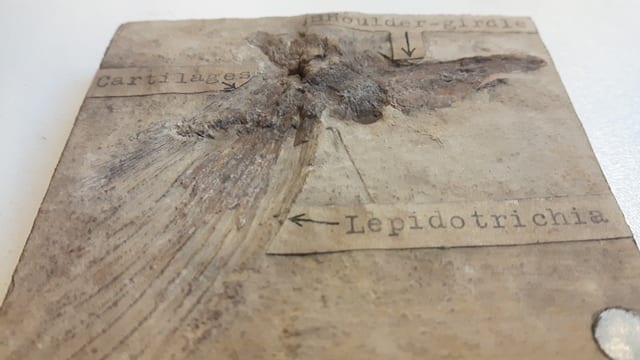Underwhelming Fossil Fish of the Month: January 2016
By Mark Carnall, on 29 January 2016
January 2016 was a big month for palaeontology in the media. This month you may have caught a programme on fossil Mesozoic vertebrate finds featuring one of the most beloved natural historians, some might go as far to say, ‘National Treasure’. No, I’m not talking about David Attenborough and some big dinosaur, that’s the easy route to media coverage. I’m talking about our very own underwhelming fossil fish on Radio 4’s Inside Science programme. If you’re new to this blog series, the humble goal is to increase global fossil fishteracy one underwhelming fossil fish from the Grant Museum collections at a time.
You might expect that with the boost in coverage, we’d have some timely underwhelming fossil fish merchandise to shill, a calendar perhaps or a pack of underwhelming fossil fish Top Trumps cards. However, as I’ve told numerous producers this week who tried to secure the underwhelming fossil fish of the month film rights, this is not the UFFotM way. We’re going to be ploughing on ahead with yet another uninteresting fossil fish, not one that’s any more or less underwhelming, just another un-noteworthy, comme ci, comme ça fossil. No fuss and especially no muss.
Here’s this month’s fossil, note THE LABELS
According to the catalogue entry for this specimen, this is part of the pectoral girdle and fin identified as Lepidotes sp. Between the catalogue information and the HELPFUL LABELS, usefully pasted onto the surface of the specimen in a not-easy-to-remove-according-to-contemporary-museum-best-practice way here, there’s not much more for me to add. Lepidotes is an extinct genus of very fishlike ray-finned fish found in Mesozoic (Triassic, Jurassic and Cretaceous) rocks and due to scales coated with enamel, nice complete body fossils are often found, unlike the example we probably have here. Lepidotrichia, is a fancy name that refers to the fins of bony fish, the largest and most successful group of fish.
Preservation Although we don’t have a huge amount of the fish preserved, what is preserved here is very nicely preserved as this alternative risqué shot shows and although it’s not clear, even the ‘cartilages’ may be preserved.
The collection locality of this specimen is unknown but from the preservation and the covered up preparator’s mark (possibly the same mark as this Grant Museum Rhamphorhynchus fossil) this specimen could be from the Solnhofen limestone, a Lagerstätte site, where exceptionally preserved fossils can be found. From the helpful educational labels this specimen was probably used for teaching purposes, to demonstrate the evolution of the shoulder girdle.
Research Unlike most of the fish featured in this series, Lepidotes, continues to appear in the scientific literature. A combination of hardened scales and a better chance of preservation with what seemed to be a very widespread distribution, more than 25 Lepidotes species have been described from freshwater and marine sediments from over other thirty countries. However, Lepidotes is a well known wastebasket taxon – a group that’s probably more complex than is currently described with every Lepidotes-like thing just bundled into a catch-all group. In the 2012 gripping read, Phylogenetic Interrelationships of Ginglymodian Fishes (Actinopterygii: Neopterygii) (Arbarello 2012), a large group of ray-finned fish were re-evaluated and it was found that not only was Lepidotes in the wrong group but that many of the old Lepidotes species belonged in another genus or family entirely. ‘True’ Lepidotes fish are now thought to be restricted to the Jurassic period alone. Where this leaves our unspeciated Lepidotes fossil without a collection locality is a bit of a mystery as we don’t have enough preserved here to assess it and relate it to the newly suggested groups.
In Society Until recently, aside from appearing on a 1999 Sahrawi Arab Democratic Republic stamp, Lepidotes‘ only route into mainstream culture was that Lepidotes teeth and scales were found preserved as stomach contents in B-list dinosaur Baryonyx. Sadly for Lepidotes, the fish found inside Baryonyx was one of the groups moved out of Lepidotes in the aforementioned re-jig of the wastebasket taxon, making this genus 68% less interesting, almost overnight.
Lepidotes sp.
Preservation 8
Research 6
In Society 2.72%
Underwhelmingness 6
Reference
López-Arbarello A (2012) Phylogenetic Interrelationships of Ginglymodian Fishes (Actinopterygii: Neopterygii). PLoS ONE 7(7): e39370. doi:10.1371/journal.pone.0039370
Mark Carnall is the Collections Manager (Life Collections) at the Oxford University Museum of Natural History, and former Curator of the Grant Museum
3 Responses to “Underwhelming Fossil Fish of the Month: January 2016”
- 1
- 2
-
3
Underwhelming fossil fish of the Month December 2016 | UCL Museums & Collections Blog wrote on 31 December 2016:

[…] fish was lovingly labelled, February’s fossil was rather revealing. Nobody noticed that the March one went missing. […]
 Close
Close




I heard you talking on R4 and looked forward very much to being underwhelmed, but actually, that one’s fairly whelming! The fin looks very well preserved and is quite pretty.